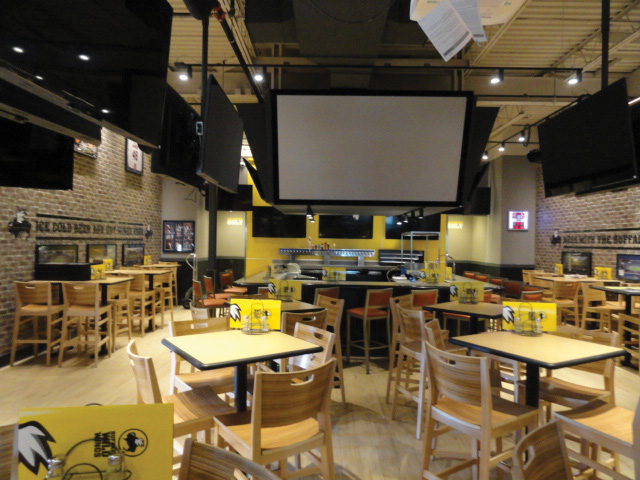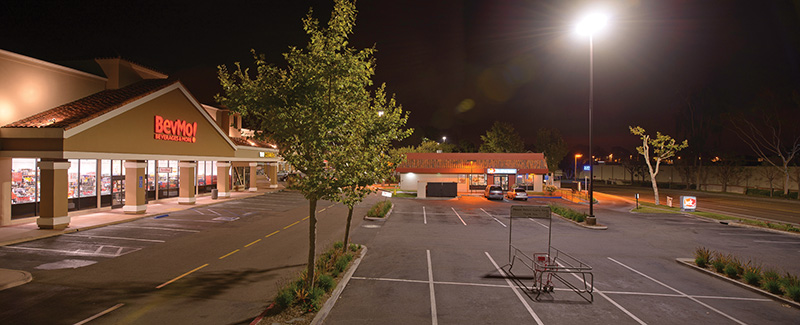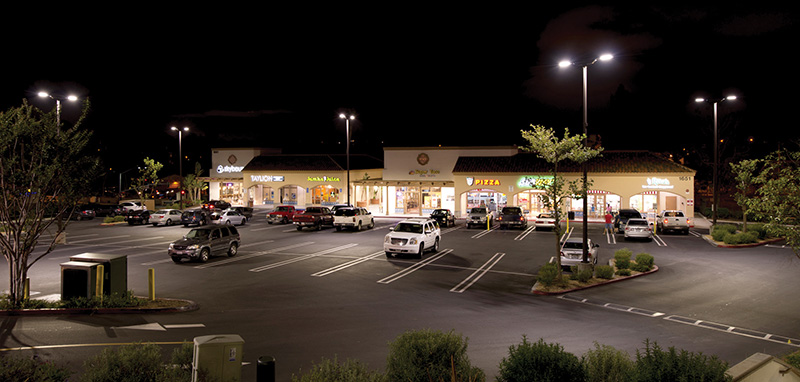One-stop shopping delivers efficiency for lighting strategies.
By Wayne Tokkesdal & Tony Broughton
The days when lighting received little more than a passing thought and a simple flip of the switch from “on” to “off” are long gone. Lighting systems have emerged as an integral part of store design and operations.
 Lighting sets the stage for the overall design aesthetic, ambiance and brand image. At the same time, stores need to view the practical side of lighting and the impact on factors such as cost, safety and energy efficiency. However, there is no cookie cutter approach or one-size-fits-all solution to lighting. Every situation is unique based on the type of business, their goals and objectives. The type of facility and locational factors also can add dozens of variables to the overall lighting design.
Lighting sets the stage for the overall design aesthetic, ambiance and brand image. At the same time, stores need to view the practical side of lighting and the impact on factors such as cost, safety and energy efficiency. However, there is no cookie cutter approach or one-size-fits-all solution to lighting. Every situation is unique based on the type of business, their goals and objectives. The type of facility and locational factors also can add dozens of variables to the overall lighting design.
The lighting specifications for a fast-casual versus a fine dining restaurant, for example, can quite literally be like night and day. Even within the same brand there can be variations to lighting plans to interior and exterior lighting at individual locations in order to reflect the nuances of a particular building, shopping center or surrounding residential or business neighborhood. Lighting a street-front store in South Boston can be vastly different than lighting a mall location in suburban Columbus.
One solution for companies looking to navigate a course through what has become an increasingly complex industry is leveraging the resources of a national accounts program at a full-service lighting firm that can deliver expertise, efficiency and economies of scale, not just at a single store, but across a portfolio of stores in multiple cities and states throughout the country.
 One-Stop Shopping
One-Stop Shopping
Companies are under more pressure to consolidate service providers to create added value and cost savings, and that same phenomenon is gaining traction in the lighting industry. Increasingly, the focus on vendor consolidation means choosing a one-stop vendor partner that can provide a full menu of services. Some companies want a full, turnkey service from start-to-finish, while others may need to use build-to-order services on an as-needed basis. Other businesses want and need that turnkey option that can help plan, design, execute and manage their lighting programs across multiple locations. In that case, it is important to choose a company that offers a comprehensive menu of services that check all of the boxes in terms of:
- Preliminary on-site survey
- Lighting & energy audits with full reporting
- Design specification/photometric drawings
- Cost estimates with projected ROI
- Rebate management
- Electrical engineering
- Purchasing & installation
- Construction management
- Managed extended warranty programs
- Ongoing maintenance programs and monitoring
The underlying philosophy for a national account program is to establish a long term partnership. For many companies, managing lighting programs is an ongoing process. Often, projects span 5 to 10 years as new lighting is implemented across a regional or national portfolio of existing and new locations. It is important to find a partner that can work alongside you through every stage of a project. That relationship also adds important consistency to the design, budget and return on investment (ROI) for multiple projects and locations around the country that might be in various stages of new construction, renovation or undergoing a lighting retrofit.
 Expertise at Each Stage
Expertise at Each Stage
The lighting industry itself has seen transformative change in terms of the design trends, technology, products and operating systems. For example, lighting fixtures are rarely just an “off-the-shelf” purchase and are designed or specialized to achieve the desired look and effect. That is why it is critical to have a partner who has the expertise and knowledge that can be leveraged at each individual phase, and also see the bigger picture of how everything is inter-connected to achieve maximum performance and cost efficiency.
Most people don’t realize just how much work goes into the preliminary planning — project evaluation, lighting design and specification, as well as the budget process — before even one fixture is purchased. Exterior and interior lighting have traditionally relied on fluorescent, incandescent, halogen, metal halide or even high pressure sodium fixtures. Now there are many options in light-emitting diode (LED) that will replace the outdated fixtures and improve the lighting without sacrificing the desired design or curb appeal. At the same time, LED also provides significant energy savings and will reduce or eliminate ongoing maintenance costs.
Surprisingly, it is still common practice to find a sales person who is selling the exact same light fixture from project to project. The reality is that those fixtures have many different lighting levels. What works great in one situation, may result in a property that is over-lit or under-lit depending on the location and other factors, such as existing lighting and neighborhood. The customer may not get the desired result, and the type of fixture also impacts the price of the fixture and ongoing utility cost. So, making a mistake in choosing the light fixture is one that a customer can keep paying for year after year.
 That is why it is more important than ever for companies to conduct a project analysis and develop a lighting plan that considers different options that take into account the design and amount of lighting along with the costs and ROI of those options. It is also important to design to the needs of a particular property. Partner with someone who can create lighting design specifications to use in different scenarios. Specific to lighting exterior parking lots, for example, we typically provide three different design levels for exterior parking lot lights depending on how a property is rated in terms of crime, safety and city code. Our electrical engineering team is licensed in all 50 states and Canada and has knowledge of expertise on building codes that can vary widely from city to city and state to state.
That is why it is more important than ever for companies to conduct a project analysis and develop a lighting plan that considers different options that take into account the design and amount of lighting along with the costs and ROI of those options. It is also important to design to the needs of a particular property. Partner with someone who can create lighting design specifications to use in different scenarios. Specific to lighting exterior parking lots, for example, we typically provide three different design levels for exterior parking lot lights depending on how a property is rated in terms of crime, safety and city code. Our electrical engineering team is licensed in all 50 states and Canada and has knowledge of expertise on building codes that can vary widely from city to city and state to state.
Generating Value and ROI
Every lighting situation is unique. Some companies are driven by the aesthetic, while for others the priority is energy efficiency, reducing costs or improving sustainability. Often, it is a combination of all of those factors. In every situation, companies have a keen focus on weighing their options against the cost, projected ROI and creating other value-add benefits from new lighting systems, upgrades or more extensive lighting retrofits.
In any project, there are numerous ways to reduce costs and add value. The “low-hanging” fruit these days is switching to more energy-efficient fixtures and automated controls. Lighting also can contribute to higher property values, as well as have a positive impact on attracting more customers, improving safety and employee productivity.
Lighting retrofits produce significant savings when introducing more energy-efficient products, such as LED. Industry research shows that LEDs use up to 80% less energy and last approximately 10 times as long as compact fluorescent bulbs, and 133 times longer than the typical incandescent bulbs. Automated sensors and timers also help to reduce wasted electricity by turning lights off when certain areas are not occupied, such as a restroom or storage room.
Energy-efficient lighting systems can also have a major impact on a company’s bottom line and the planet. In 2016, we helped to identify and create energy savings for clients that resulted in:
- Annual energy cost savings: $3,429,271
- Reduced electricity consumption: 29,965,595 kWh
- Prevented the release of 21,059 Metric Tons of Carbon Dioxide
Working with a national accounts program helps companies to maximize savings by leveraging favorable rates and greater purchasing power to negotiate the best pricing from manufacturers. It also is important to tap into other savings available through the myriad of energy rebate programs available from different sources around the country from utilities and government entities.
As an example, a retrofit project to replace (100) 400W metal halide high bay fixtures to (100) 250W LEDs results in up to 60% of the project cost savings in rebates alone. The rebates, in addition to energy savings of $25,000 along with further maintenance savings, is expected to deliver a total payback on the company’s investment in less than 5 months.
Although rebate programs can deliver significant savings, they also can be challenging to navigate across a portfolio of properties. Look for a dedicated rebate management department that identifies, applies for and tracks all available lighting rebates nationwide.
Ultimately, there are a lot of choices in lighting solutions today with new product innovations that are continuing to emerge at a rapid rate. Therefore, it is critical to choose a partner with the expertise and knowledge that can help to create and execute a strategic lighting plan that will deliver maximum performance, cost efficiency and consistency across a local, regional or national portfolio of properties.
— Wayne Tokkesdal is president/CEO of On-Site Lighting & Survey, LLC, and Tony Broughton is vice president of national accounts. On-Site Lighting & Survey is a nationally recognized leader in the lighting industry that provides indoor and outdoor lighting programs for retail, industrial, commercial, municipal and residential projects.
